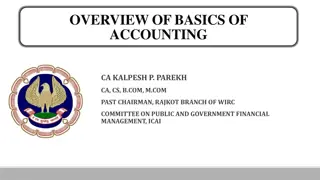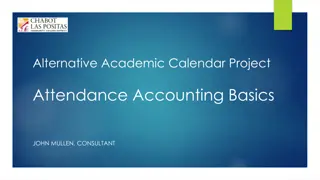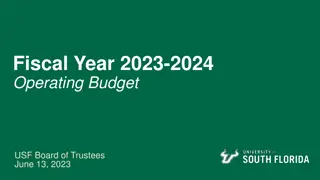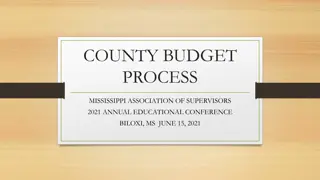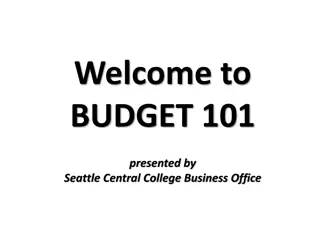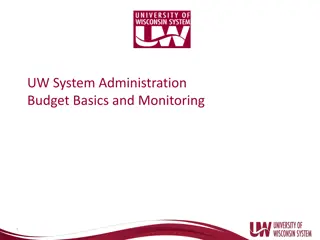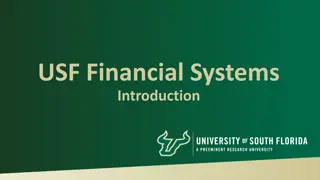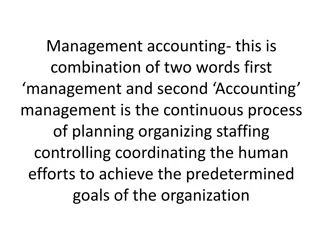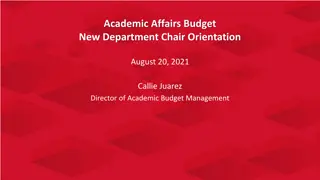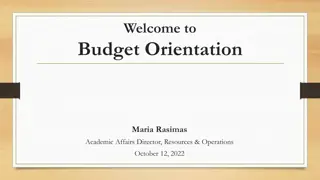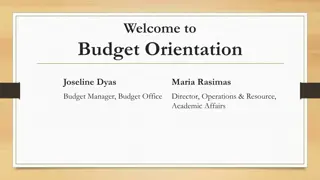Understanding Basic Accounting Concepts and Budget Management at USF
This content provides valuable insights into basic accounting concepts such as budgeting, journal entries, accrual accounting, and budget management processes at USF. It covers essential topics like budget checking initiation, expense incurring methods, and budget impact on different financial transactions. The information is presented through detailed images and descriptions, offering a comprehensive understanding of accounting principles and budget control strategies.
Download Presentation

Please find below an Image/Link to download the presentation.
The content on the website is provided AS IS for your information and personal use only. It may not be sold, licensed, or shared on other websites without obtaining consent from the author. Download presentation by click this link. If you encounter any issues during the download, it is possible that the publisher has removed the file from their server.
E N D
Presentation Transcript
Basic Accounting Concepts
Agenda Budget Guiding Principles Voucher Journal Masks / Entries Accrual Accounting UCO Resources 2
Budget Managing and Checking Budgets Incurred Expenses RSA Definitions
Managing Our Budget Commitment control is used two ways Expenses are budgeted for all funding sources Tracking with budget Full budget control Budget is released to specific chart field strings A chart field is a way to tag a transaction Chart fields are grouped together as a chart field string to direct how the accounting entry is recorded and reported Also used for revenue tracking in auxiliary funds 5
When does USF budget check? Budget checking is initiated when: A requisition is submitted A purchase order is created A change order is submitted An invoice is paid An expenditure transfer is submitted An interdepartmental billing is submitted Travel authorization is submitted Travel expense report is submitted PCard expense is posted A customer billing is created A deposit is recorded by a cashier During automated nightly processing On demand by authorized users 6
How does USF incur expense? Expense Method Budget Impact Salary Not encumbered; RSA is reduced when salary is posted Travel Authorization Encumbered when the travel authorization is created; reduces RSA Travel Expense Report Not encumbered; RSA is reduced when the expense is posted PCard Purchases Not encumbered; RSA is reduced when the expense is posted Expense Action Budget Impact Encumbered when the requisition is created Item purchased with a purchase order Not encumbered; RSA is reduced when the journal entry is posted in general ledger Interdepartmental buying; departments sell to each other Not encumbered; RSA is reduced on the new chart field string and increased on the old chart field string when the transaction is posted in general ledger Expenditure transfers 7
How does USF account for Funds? USF practices fund accounting Funds are categorized in a fund group Within the fund groups, there are individual fund IDs All are subject to budget checking Fund accounting helps ensure proper use of funds; accountability is the key 9
Definitions Public purpose General revenue (often referred to as E&G) State funds allocated by the legislature to USF each fiscal year; derived from sales tax collections These funds begin with a 1 Carry-forward funds Unspent general revenue funding from the prior fiscal year These funds begin with a 1 ; normally 10009 Auxiliary funds Auxiliaries require an EBA approved by USF Controller s Office to conduct commercial business activities with customers outside USF Auxiliaries at USFSP begin with a 07 ; at USFSM with a 06 10
Definitions Special purpose Sponsored research funds Allocated by a federal, state or private agency to USF with a PI (project investigator) identified with a specific line item budget RIA - research initiative may include F&A recovery and residuals from fixed price contracts Faculty startup Internal awards These funds begin with 183 These funds are subject to full budget control Student fees Tuition and fees paid to USF by the students to be used only for student support 11
Definitions Not USF money Student financial aid May be received from federal, state, or private sources May involve a transfer from the USF Foundation Agency funds For example sales tax collected from commercial sales of services to customers outside of USF Convenience funds Reimbursement received from a DSO - for example UMSA receiving funds in acknowledgement of effort expended by USF staff in support of the USF College of Medicine clinics 12
EBA Educational Business Activity An EBA is a revenue-raising activity that supports the overall mission of USF. Departments and units submit the request to the Controller s Office for authorization to conduct a business Find information and forms on the University Controller s Website Submit a request to create a new EBA or to update an existing EBA Include in the request EBA Request Form EBA Business Plan EBA Schedule 13
Guiding Principles State Funds Auxiliary Funds Research
Guiding Principles State Funds Concepts State appropriations must be expended in accordance with the State Department of Financial Services, Division of Accounting and Auditing In general moneys may only be expended for reasonable and appropriate goods or services necessary to accomplish the mission of the University (teaching, research, and public service) Generally spending is allowed from any of the expense account code categories unless specifically addressed in Florida Statute or USF guidelines State and USF negotiated contracts with vendors must be observed Restrictions If the item for payment is generally used solely for the personal convenience of employees and which generally are not necessary in order for the University to carry out its statutory duties, the unit must provide justification for the purchase of these items or perquisite approval by an appropriate official E&G moneys cannot be expended to satisfy the personal preference of employees For example, cannot be used for Portable heaters, fans, refrigerators, stoves, microwaves, coffee pots or supplies, picture frames, wall hangings, decorations, etc. 15
Guiding Principles State Funds (continued) More specific restrictions Expenditures from state funds for the following items are prohibited unless expressly provided by law Congratulatory telegrams Flowers and/or telegraphic condolences Presentment of plaques for outstanding service Refreshments such as coffee or doughnuts Decorative items (artwork, plants, etc.) Greeting cards 16
Guiding Principles Auxiliary Funds Concept Auxiliary moneys may be expended for any goods or services necessary to fulfill the mission and programmatic needs for which the auxiliary was established under the USF authorized EBA Find more information by searching for EBA on Business Processes Generally spending is allowed from any of the expense account code categories unless specifically addressed in Florida Statute or USF guidelines 17
Guiding Principles - Research Concept These funds are much more restrictive in that expenditures must meet the specific budgetary requirements of the project as specified in the Notice of Award. Some projects may also specify expenditures that would otherwise not be allowed Examples are payments to research participants and certain items of a personal nature that are necessary as part of the sponsored project (example: food or clothing items) Sponsored Research Federal research governed by OMB circulars A-21, A-110 and A-133; there are also specific Cost Accounting Standards that apply State agencies and private foundations also have specific guidelines USF Internal Awards Program The mission of the Internal Awards Program is to foster excellence in research and scholarship by USF faculty and support activities aimed at securing extramural funding Consult USF Research for more details 18
Voucher What is a Voucher? Voucher Accounting Entry Voucher Information
What is a Voucher? A voucher can be defined as a document used in an internal control system to contain and verify all information about a bill to be processed or paid Vouchers are recorded in the Accounts Payable module and are managed by UCO Accounts Payable Vouchers have unique identifying numbers At USF, voucher ID s are eight digit beginning with a zero 20
The Voucher Accounting Entry Vouchers are produced After receiving the vendor invoice After matching occurs (matching the PO, vendor invoice, and receiving document) After the bank bills USF for PCard activity An accounting entry is created Recording the expense (a debit to expense) Recording a liability to the vendor (a credit to liability) A typical voucher accounting entry would look like the below: 21
The Voucher Information Remember the USF chart of account codes Liability accounts begin with a 2 Vendor expense accounts begin with a 5 or 6 A voucher is packed with vendor and payment information Find voucher information in the accounts payable module of FAST 22
Journal Masks / Entries What is a Journal? Journal Mask Journal Entries How to submit a Journal Entries Deadlines for Journal Entries Where to send Journal Entries
What is a Journal? Most transactions are created in various modules (aka subsidiary ledgers) Transactions that are similar in nature are batched into journals The journals are posted to the general ledger The general ledger displays high level summary of accounting transactions based on chart fields and accounting periods Journals have unique identifying numbers The numbering scheme for journals is Letters (usually three); called a journal mask Seven digits automatically assigned by the system in sequence The journal ID is unique The journal mask (the letters) identifies either the character of the transactions or the source of the transactions To understand journal masks, use the University Controller s Office Website Internal Accounting Services 24
Sample of Common Journal Masks Journal Masks Definition APA accounts payable accrual (vouchering) APP accounts payable payments to vendors BNR transactions originating in Banner/OASIS TAS telephone billings from USF IT EXA travel expense accrual EXP travel expense reimbursements ARB accounts receivable billings to customers ETR non-payroll expenditure transfer 25
Journal Entries Journal entries are balanced accounting transactions posted directly to the general ledger Journal entries may need to be created Resulting from discovery during reconciliation To initiate an expenditure correction To initiate a cash correction To initiate an interdepartmental billing All journal entries are budget checked Including expenditure transfers Including interdepartmental billings *Choose the right journal mask 26
Journal Entries can be delayed Budget issues Insufficient RSA (remaining spending authority) Chart field string never had budget released If a grant, the transaction date is out of bounds Accounting coding An invalid chart field is being used An invalid chart field string is being used (combination edit) A sponsored project may have passed it s ending date 27
How to submit Journal Entries Journal entries need supporting documentation for audit purposes - this provides a sound audit trail Journal entries may be Non-payroll expenditure transfers Payroll expenditure transfers (may be referred to as RETS) Interdepartmental billings Use the journal entry template It is in the format of an Excel spreadsheet Find it on the Controller s Office Website - Journal Entry Template Attach to the journal spreadsheet An image of the invoice An image of the finance mart page illustrating the original expense posting 28
Deadline for Journal Entries RETS should be prepared promptly after the error occurs but no later than 90 days following the date of the occurrence unless a longer period is approved in advance Cost transfers for expenditures being removed from sponsored research projects to a non-project related account due to clerical or bookkeeping errors should occur as soon as the error is detected regardless when the error occurred All FWS RETS need to be submitted within 30 days and should be sent to Student Financial Services for secondary approval. 29
Where to send Journal Entries Expenditure Transfers RNSexpt@usf.edu Cash Receipt Corrections RNSinterdept@usf.edu Departmental Billings RNSinterdept@usf.edu 30
Accrual Accounting What is Accrual Accounting? Illustration of Expense and Vendor Payments Illustration of Revenue and Customer Payments Accounting Periods
Accrual Accounting Two primary methods of accounting are Cash basis Accrual basis USF uses a modified accrual method Accrual is all about timing For instance the timing of When an expense is recognized Expense is recognized when it occurs, not when it is paid When revenue is recognized Revenue is recognized when it is earned, not when it is collected It leads to a more accurate reporting of our financial condition 32
Accrual Accounting (continued) Accrual expense entries Expense is recorded subsequent to the voucher being created This is the point when the vendor debt is acknowledged Even though actual payment may not be paid for several days The accounting entry created by the voucher is A debit to expense Account beginning with 5 or 6 A credit to accounts payable Account beginning with code 20000 Accrual revenue entries Revenue is recorded when it is earned Revenue is earned when the customer is invoiced Customer invoicing is created in the billing module The accounting entry created by the customer invoice is A debit to accounts receivable Account 12010 A credit to revenue Account code beginning with 4 33
Illustration of Expense and Vendor Payment Recognize Expense and Vendor Debt Amount Oper. Unit Fund GL Acct. Dept. Product Initiative Debit $ 3,000.00 TPA 10000 53600 020600 PFS001 0000000 Credit $ (3,000.00) TPA 10000 20000 Record Vendor Payment and Clear Vendor Debt Amount Oper. Unit Fund GL Acct. Dept. Product Initiative Debit $ 3,000.00 TPA 10000 20000 Credit $ (3,000.00) TPA 10000 10031 34
Look at it from a different view This illustration may help In the accounting world a T account is sometimes employed to work through an accounting issue The left side of the T is for the debit or positive entry The right side of the T is for the credit or negative entry 35
Look at it from a different view (continued) Record expense and accounts payable after the voucher is created; the accounting entry appears in yellow Pay the vendor and clear the account receivable; the accounting entry appears in orange 36
Illustration of Revenue and Customer Payment Recognize Revenue Amount Oper. Unit Fund GL Acct. Dept. Product Initiative Debit $ 500.00 TPA 03600 12010 Credit $ (500.00) TPA 03600 44000 042700 000000 0000000 Record Customer Payment Amount Oper. Unit Fund GL Acct. Dept. Product Initiative Debit $ 500.00 TPA 03600 10011 Credit $ (500.00) TPA 03600 12010 37
Look at is from a different view An Auxiliary makes a sale; this accounting entry in green records the revenue of the sale and the account receivable When the customer pays USF, the blue entry records the cash deposit and clears accounts receivable 38
Accounting Things to look for All accounting entries have a sign Debit is the term for a positive entry amount Credit is the term for a negative entry amount All accounting entries must balance The credits (negatives) must balance to the debits (positives) An accounting entry will not post to general ledger unless it is in balance GL account codes that naturally have a debit balance Expenses (beginning with 5, 6, or 75) Assets (beginning with a 1) GL account codes that naturally have a credit balance Revenue (beginning with a 4 or 74) Liabilities (beginning with a 2) 39
Accounting Things to look for Expenses and Assets Increase with a debit (plus value) Decrease with a credit (negative value) Revenue and Liabilities Increase with a credit (negative value) Decrease with a debit (plus value) 40
Accounting Periods The USF fiscal year is July 1 through June 30 Our accounting periods Periods 1 through 12 represent July through June Period 998 is the adjustment period Period 0 represents balance sheet account balances brought forward from prior fiscal year to next fiscal year 41
University Controllers Office Resources Contacts Additional Information
Helpful Resources Email Department aphelp@usf.edu Accounts Payable Help Asset-help@usf.edu Asset Management Help billingarhelp@usf.edu Billing and AR Help cashiers@usf.edu Cashiers Office Help Electronic-media-disposal@usf.edu Electronic Media financemart@usf.edu Finance Mart Questions payrollhelpdesk@usf.edu Payroll Questions pcard@usf.edu PCARD Questions travelhelp@usf.edu Travel Questions usfpurchasing@usf.edu Purchasing Help 43
Look for the TRAIN Online Business Processes The Research Administration Improvement Network The address is www.usf.edu/businessprocesses Allows for keyword search or category search You may pose questions Look for information on Accounting practices HR-payroll Purchasing Research The USF Foundation And many other subject areas www.research.usf.edu/train The Goals Building the knowledge base of research administrators Enhancing professional competencies Improving business processes and reporting 44
University Controllers Office (UCO) o http://www.usf.edu/business-finance/controller UCO Administrative Services, Accounting & Reporting, Student Services, Travel & Accounts Payable, Payroll & Tax Services, and Procurement. Important ListServ accounts: o FAST ListServ Visit http://listserv.usf.edu/scripts/wa.exe?A0=FAST-LIST to subscribe; click Get Password o Travel ListServ Travel home page to subscribe o Payroll ListServ Look on the Payroll Overview page to subscribe o Purchasing ListServ 45





